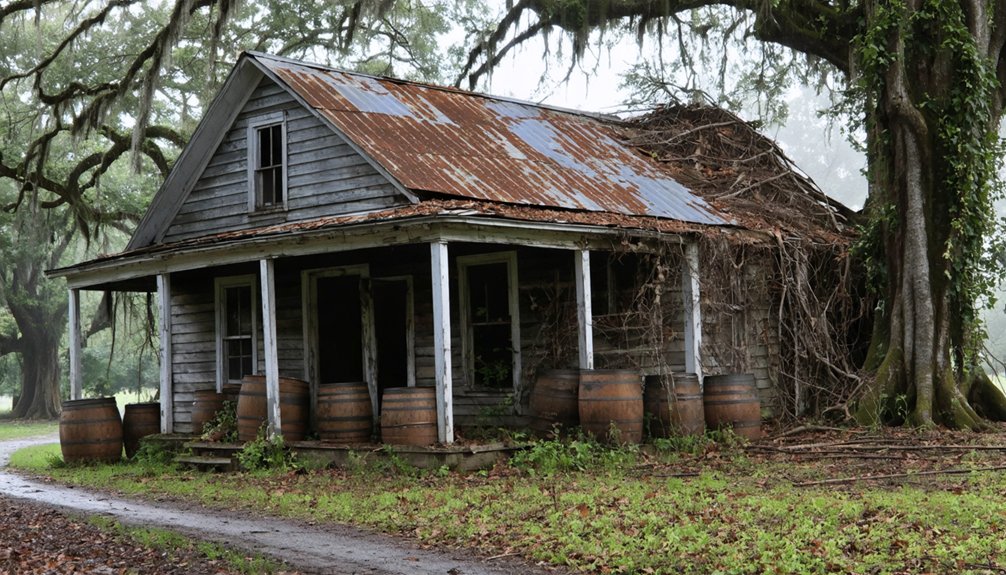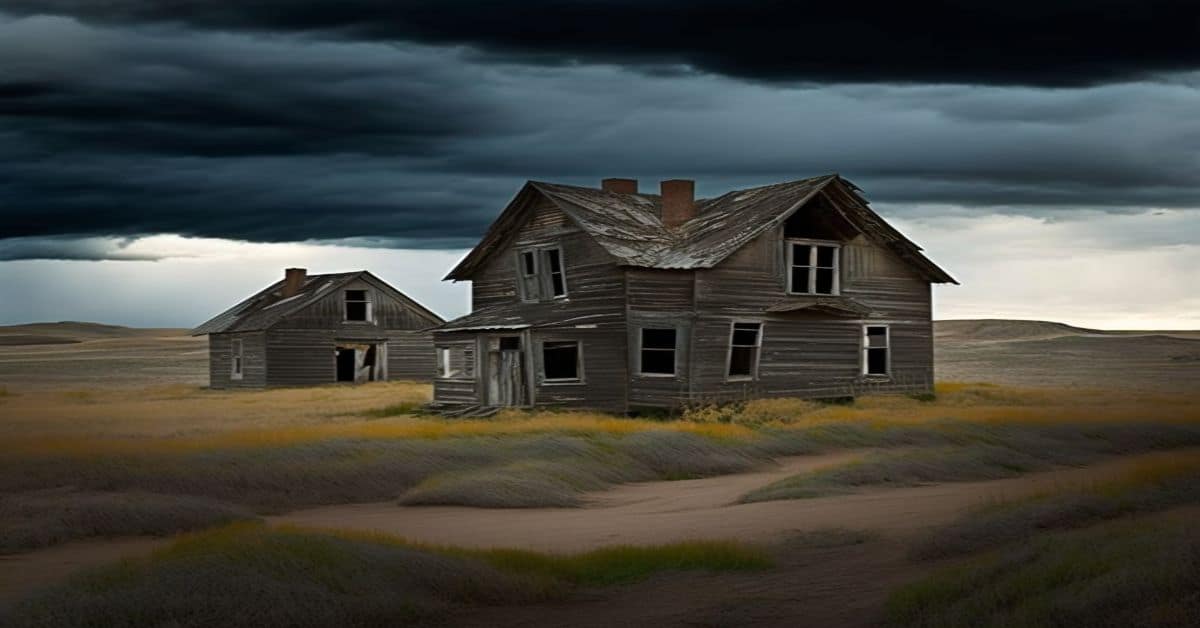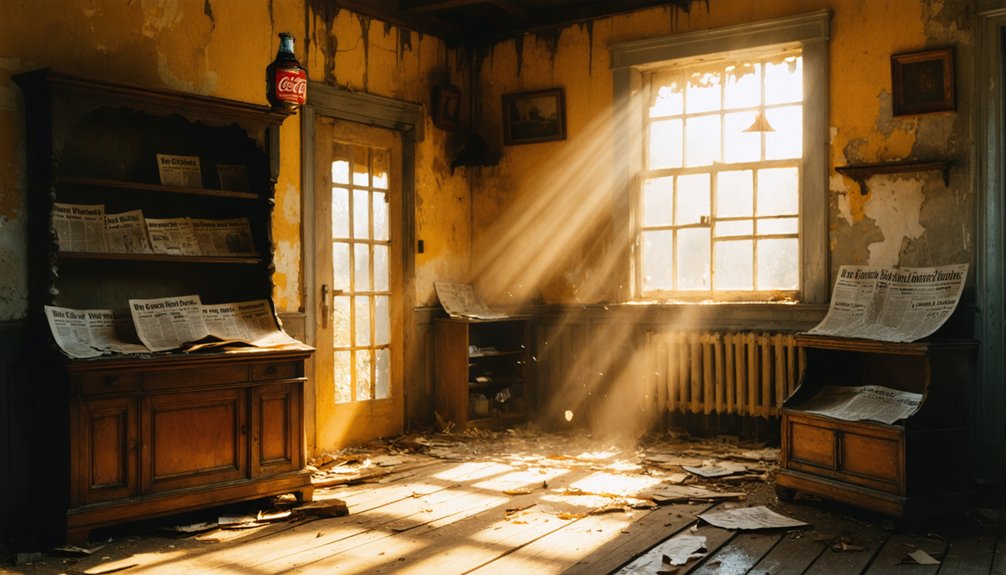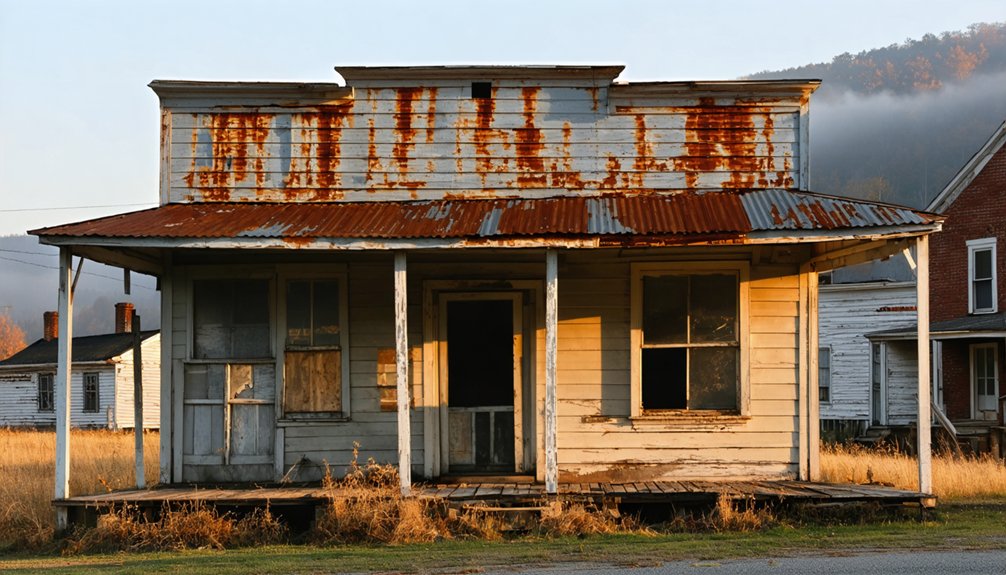You’ll find Bear Wallow, Kentucky at the crossroads where essential 19th-century transportation routes once met, 9 miles from Glasgow and 7 miles from Munfordville. This ghost town earned its name from bears cooling off in mud depressions near a local spring. Once home to a bustling tavern, post office, and the historic Bear Wallow Church, it played a strategic role during the Civil War. Today, its abandoned buildings and supernatural legends tell deeper stories of Kentucky’s mysterious past.
Key Takeaways
- Bear Wallow is an abandoned Kentucky town located 9 miles from Glasgow, named after muddy depressions where bears once cooled off.
- The town thrived in the 1840s with a tavern, post office, and church before declining due to changing transportation routes.
- During the Civil War, Bear Wallow served as a strategic crossroads for Confederate operations, particularly Morgan’s raiders.
- Local supernatural legends include stories of Ary Edwards’ spirit, witchcraft, and mysterious gray creatures in the woods.
- Today, Bear Wallow stands as a ghost town at coordinates 37°42′13″N 85°19′3″W, with abandoned buildings and overgrown surroundings.
Origins of the Mysterious Crossroads
While many Kentucky crossroads have faded into obscurity, Bear Wallow‘s origins stem from its strategic position at the convergence of vital transportation routes in Barren County.
In Kentucky’s storied landscape, Bear Wallow emerged as a crucial crossroads, marking where major travel routes intersected in Barren County.
You’ll find its name rooted in frontier crossroads folklore, where early settlers observed bears cooling off in natural mud depressions near a local spring.
The spot’s significance grew as it became a key junction 9 miles from Glasgow and 7 miles from Munfordville, serving travelers headed to destinations like Mammoth Cave.
By the 1840s, you’d have encountered a bustling village complete with a tavern, post office, and the Bear Wallow Church where the infamous trial of Mary Edwards occurred in 1813.
The crossroads’ natural features and positioning made it an ideal rest stop, while its wildlife-inspired name captured the raw essence of Kentucky’s frontier landscape.
Life in Early Bear Wallow Settlement
As Bear Wallow emerged from Kentucky’s frontier days, you’d have found a tight-knit community of Revolutionary War veterans, farmers, and God-fearing families settling around the crossroads.
You’d see folks gathering at the white-washed Bear Wallow Church for Sunday services, where they’d share news and stories while their children played near the adjacent graveyard.
Rural livelihoods centered on farming the rolling Barrens prairie and hunting the bears that gave the settlement its name.
Local taverns welcomed travelers heading to Mammoth Cave, while the post office served as a crucial communication hub.
A small African-American settlement called Brack Dol emerged nearby, and children attended the local Blue Spring School.
Community gatherings strengthened bonds between neighbors who relied on each other through generations of rural life.
Natural Features and Wildlife Heritage
Before modern development reshaped the landscape, Bear Wallow‘s natural terrain showcased Kentucky’s diverse ecological heritage.
You’ll find this crossroads community nestled among rolling Bluegrass hills, where natural springs and streams once attracted abundant wildlife diversity. The settlement’s name comes from a muddy depression where bears would wallow, highlighting the area’s rich ecological balance before settlement changed the region.
Bears once found sanctuary in this Kentucky hamlet’s muddy hollows, leaving their mark on both the land and its name.
The land supported classic Kentucky wildlife, from white-tailed deer to wild turkeys, while hardwood forests provided shelter for countless species. Today, visitors can explore the area’s natural beauty during fall weekend visits as the farm opens its gates from mid-September through October. The area is located just 30 minutes away from Mammoth Cave National Park‘s New Entrance, offering additional opportunities to explore local ecosystems.
You can still sense this heritage in the surrounding region, which connects to larger protected areas like Mammoth Cave National Park. While the bears may be gone, the terrain’s varied elevation and water features continue supporting diverse flora and fauna typical of Kentucky’s native ecosystems.
Civil War Strategic Significance
You’ll find Bear Wallow’s Civil War significance centered on its position as a critical crossroads during Confederate operations in Kentucky.
Morgan’s raiders exploited the community’s strategic location along the Louisville-Nashville telegraph line in December 1862, tapping into Union communications to gather intelligence while evading Federal forces.
The site’s natural features and existing road network made it an ideal waypoint for rapid cavalry movements, allowing Confederate forces to strike quickly and disappear into the rolling Kentucky countryside.
General Leonidas Polk’s troops passed through Bear Wallow on September 16, 1862, as part of a planned assault on Union forces at Munfordville.
The thriving village included several businesses and establishments that supported military operations during the conflict.
Polk’s Tactical Movement 1862
During the pivotal 1862 Confederate Kentucky Campaign, General Leonidas Polk‘s tactical movements shaped the outcome of Southern military operations in the region.
As commander of Bragg’s Army of Mississippi wing, you’ll find his actions both helped and hindered Confederate efforts. While Polk’s rear guard actions against Union forces from Louisville bought valuable time, his miscommunication with Bragg led to critical delays. His command confusion in battle led to the 22nd Indiana’s devastation when friendly fire caused 65.3% casualties.
His ongoing conflicts with Bragg severely impacted operational effectiveness during the campaign.
You can trace how Polk’s command decisions at Perryville exemplified broader Confederate command problems. He mistakenly halted fire against the 22nd Indiana Infantry and failed to move north to protect Frankfort when ordered.
These tactical missteps, combined with his earlier fortification of Columbus with 140 artillery pieces, ultimately couldn’t secure Kentucky for the Confederate cause.
Strategic Crossroads Position
The strategic crossroads of Bear Wallow proved essential to both Union and Confederate forces during the Civil War, with its significant position connecting Bardstown, Cisselville, Fredericktown, Manton, and McIntyre.
You’ll find this important intersection played a decisive role in military logistics, as troops and supplies moved swiftly through central Kentucky’s transportation routes.
When Confederate raiders like John Hunt Morgan struck through the area in 1862, they’d use Bear Wallow’s convergence of roads to launch attacks on Union supply lines and communications.
The nearby L&N Railroad at Glasgow made the crossroads even more valuable, prompting Union forces to fortify the region.
You can see why they built Fort Williams in 1863 – it protected these essential transportation arteries and helped maintain control over southern Kentucky’s strategic network.
Similar to the tactics used during Morgan’s Christmas Raid, Confederate forces frequently targeted the Bear Wallow area to disrupt Union operations.
Modern historians accessing disambiguation pages have helped clarify the multiple strategic locations named Bear Wallow that existed during the Civil War era.
Tales and Legends of the Abandoned Village
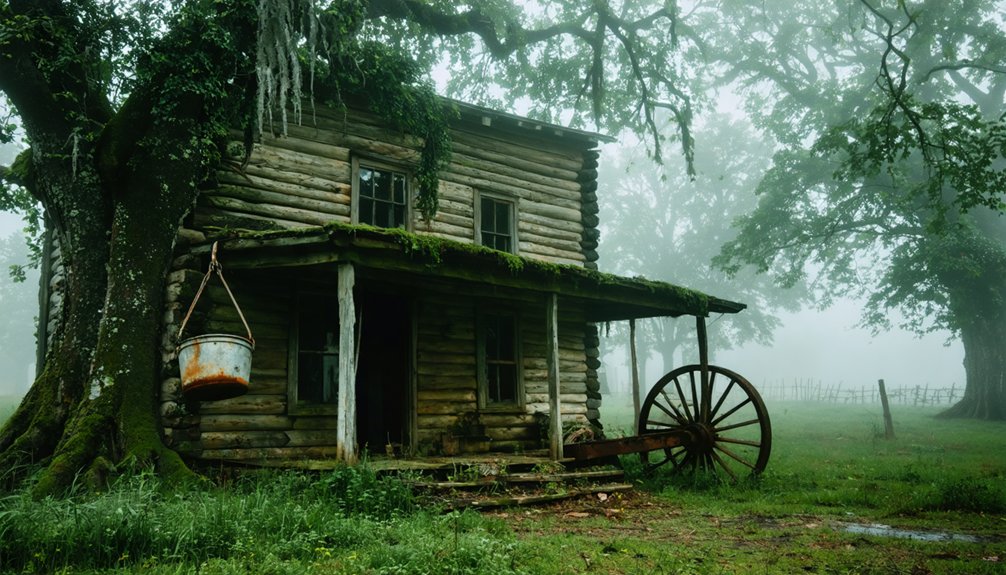
Among Kentucky’s most enigmatic ghost towns, Bear Wallow harbors a dark collection of supernatural tales that have captivated locals and visitors for generations.
You’ll find the haunting legend of the Bear Wallow Church, where Mary Edwards’ spirit supposedly lingers, whispering through storm-swept nights in the abandoned building.
The region’s witchcraft history intertwines with reports of the fearsome Wolfman of Wolfe County and the violent Bearilla, creatures that’ve left mysterious trails through woods and terrorized local farms. Many residents share experiences similar to the Caldwell family encounters, with witnesses describing tall, gray creatures stalking through the dense forest.
Beyond these, supernatural encounters persist at iron-lined graves and deserted structures, where witnesses report unexplained phenomena.
Local folklore, passed down through generations, warns against trespassing in these haunted spaces, reflecting deep-seated fears and superstitions that continue to shape Bear Wallow’s spectral legacy.
The Decline and Abandonment
Beyond Bear Wallow’s haunting reputation lay stark economic realities that sealed its fate.
You’ll find the town’s decline rooted in its economic vulnerability, as it failed to adapt when newer transport routes bypassed the once-promising crossroads. Businesses shuttered and folks moved away, leaving behind empty storefronts and fading dreams of prosperity.
The social fragmentation hit hard around 1813 when the Bear Wallow Church split apart, torn by fear and superstition.
Once the preacher left, you’d see the heart of the community crumble as religious services ceased. The Civil War dealt another blow when Leonidas Polk’s troops passed through, and post-war hardships prevented recovery.
Between the borilla attacks, ghostly church tales, and challenging terrain, you wouldn’t find many willing to stick around or invest in Bear Wallow’s future.
Present-Day Ghost Town Legacy
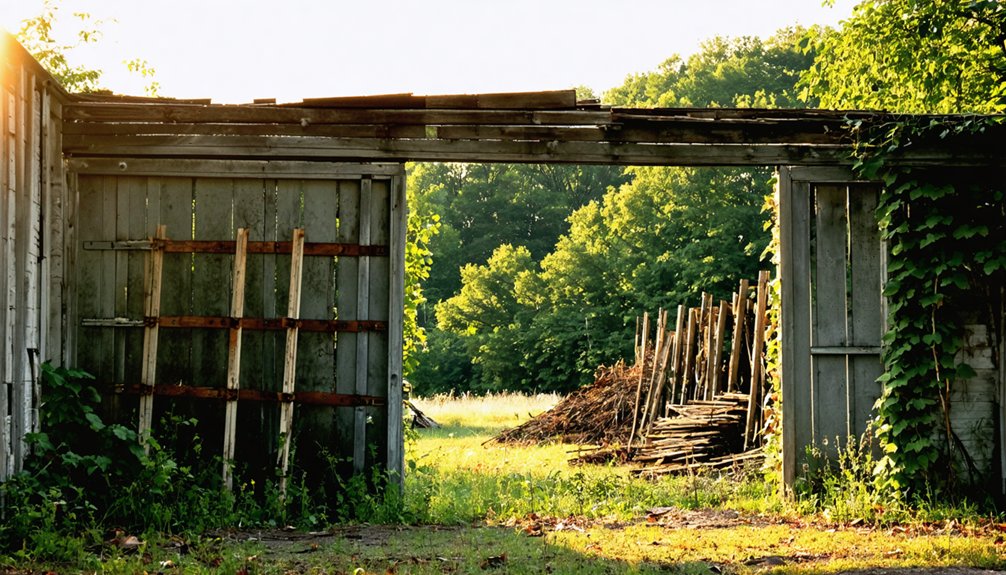
While you won’t find bustling streets or thriving businesses in Bear Wallow today, you’ll discover an atmospheric crossroads that whispers tales of Kentucky’s rural past at coordinates 37°42′13″N 85°19′3″W.
The unincorporated village’s legacy lives on primarily through local historical accounts and the Washington County Bicentennial History, which chronicle its role in early regional settlement patterns.
You can still visit this historic spot where roads from Bardstown, Cisselville, Fredericktown, Manton, and McIntyre converge, though only the quiet countryside and the namesake mud depression remain as silent witnesses to Bear Wallow’s former existence.
Abandoned Buildings Stand Silent
The abandoned buildings of Bear Wallow stand as silent sentinels to Kentucky’s rural past, with their weathered facades and overgrown surroundings telling stories of economic decline.
You’ll find abandoned architecture that speaks volumes: a brick sanctuary slowly being reclaimed by nature, historic mansions that once housed the town’s prosperous residents, and the skeletal remains of general stores where locals once gathered.
The silent stories these structures tell aren’t just about decay – they’re about the transformation of a once-vibrant community.
Walking past the old motel and lumber yard, you’re witnessing the physical remnants of Bear Wallow’s commercial heart.
While some properties still receive occasional mowing, the empty buildings and deteriorating railroad infrastructure reveal how thoroughly this town has surrendered to time, becoming a powerful symbol of rural Kentucky’s changing landscape.
Haunting Tales Live On
Since its abandonment, Bear Wallow’s haunting legacy has grown into a rich tapestry of supernatural tales, centered on the mysterious church split of 1813.
You’ll hear whispers of a witch’s curse that drove the preacher away, claiming “the Spirit had left that place.” The supernatural folklore runs deep through generations of locals who’ve passed down stories of eerie sounds, shadowy figures, and a woman’s voice echoing through stormy nights.
While you won’t find official documentation of these otherworldly claims, the legends have shaped Bear Wallow’s community identity for over two centuries.
Even today, visitors brave enough to venture near the old church site report unexplained phenomena, especially during Halloween or thunderstorms, keeping the town’s ghostly reputation alive in Kentucky’s rich tradition of haunted places.
Frequently Asked Questions
Are There Any Remaining Original Structures Still Standing in Bear Wallow Today?
Based on 0 documented structures, you won’t find any original buildings or architectural significance in today’s Bear Wallow – research limitations and lack of historical records leave its remaining structures unknown.
What Was the Peak Population of Bear Wallow During Its Height?
You’ll find that historical records don’t document Bear Wallow’s peak demographics with certainty. Based on the historical timeline and its status as an unincorporated community, population figures weren’t officially tracked.
When Was the Last Operating Business or Post Office Closed?
Like a fading frontier outpost, you’d find the last business timeline points to Hare’s Tavern operating until around 1952, when the post office’s lights also dimmed for the final time.
Has Bear Wallow Ever Been Considered for Historical Landmark Designation?
You won’t find any evidence of formal landmark consideration for Bear Wallow, despite its historical significance. While local folklore preserves its memory, there haven’t been documented preservation efforts for official designation.
Do Any Descendants of Original Bear Wallow Settlers Still Live Nearby?
You’ll find descendant stories and local folklore suggest some families remain, but there’s no definitive genealogical proof linking current residents directly to Bear Wallow’s original settlers from the 1800s.
References
- https://scholarworks.moreheadstate.edu/context/rennick_ms_collection/article/1031/viewcontent/Barren_3x5.pdf
- https://www.youtube.com/watch?v=qSfdvN9d_xA&vl=en-US
- https://en.wikipedia.org/wiki/Bearwallow
- https://www.freakyfoottours.com/us/kentucky/
- https://www.youtube.com/watch?v=6AiBwAeNHo4
- https://foxfirenation.com/listings/bear-wallow-hollow/
- https://www.hmdb.org/m.asp?m=79208
- https://history.ky.gov/markers/bear-wallow
- https://kids.kiddle.co/Bear_Wallow
- https://bluegrasswoodland.com/uploads/Historical_Notes_on_the_Big_Barrens.pdf
